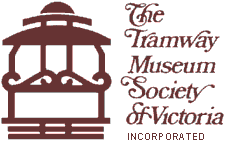
| About TMSV | Visitor information | Our collections |
Current projects | Feature articles | Join TMSV | Useful links | TMSV news |
 |
|||||||||
|
|||||||||
|
Collections
|
Geelong E No 40
This tramcar was constructed in 1914 by Duncan & Fraser for the PMTT as its fleet No 40. This car is a typical drop centre drop end maximum traction tramcar of the era. All PMTT tramcars of this type where notable for having three doors in the drop centre. It was taken over by the M&MTB in 1920 retaining its number, and classified into the E class. During its M&MTB service No 40 was allocated to Kew, Camberwell and Malvern Depots. It was sold to the SECV in 1951 for use in Geelong, and remained in service until closure of the system in 1956. On closure, the SECV transferred the tramcar to Ballarat where it became No 43. Whilst at Ballarat four seats were removed from the drop centre to allow carriage of perambulators and shopping jeeps. This tramcar is notable in that it was the last tramcar acquired for service in Geelong, and had the highest fleet number born by any tramcar in both Geelong and Ballarat. The body is in poor condition, as after closure of the Ballarat system in 1971 it was acquired by the Newtown City Council and was placed in Queen’s Park in that municipality, where it was significantly damaged by weathering and vandalism. The TMSV acquired this tram in 1986 without motors for restoration, but subsequently acquired suitable motors from Ballarat No 42. The Society is yet to select one of two options for restoration of this tramcar. The first option is to restore it to its original condition as PMTT No 40 in chocolate (actually more of an Indian Red) & cream. The second option is to restore it to its condition as Geelong No 40 in SECV mid 1950s livery, which was significantly different to the colour schemes used in Bendigo and Ballarat at that time.
|
![]() Last
updated 22
September 2004.
Last
updated 22
September 2004.
![]() Content
copyright © Russell
Jones 2001-4. Reproduced with permission.
Content
copyright © Russell
Jones 2001-4. Reproduced with permission.